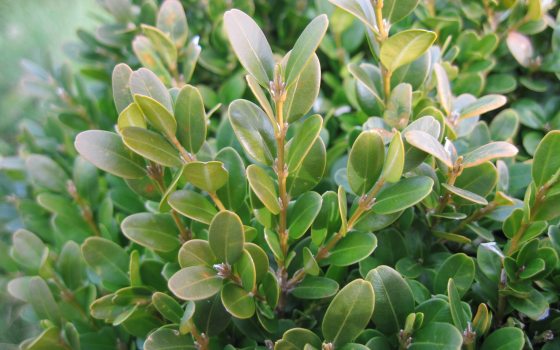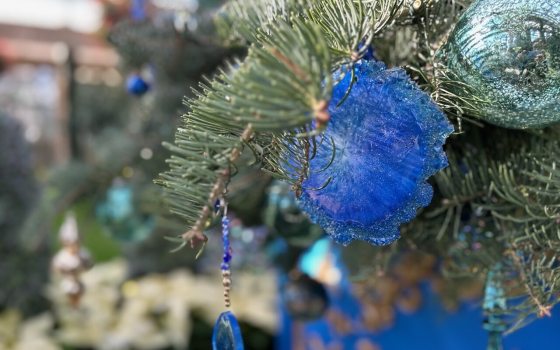Boxwood blight has become a major concern in recent years, striking fear into both the homeowner and professional horticulturist alike who suspect their plants may be infected. We first found boxwood blight in our Gardens five years ago, and since that detection we have employed extensive efforts to protect our boxwood collection throughout the Gardens—particularly in the Main Fountain Garden, which is home to approximately 3,200 boxwood plants. Read along for how, now five years after first detecting boxwood blight in our Gardens, we inspect for and protect against this disease. We also share ways that homeowners can identify symptoms of this disease, what can be confused with boxwood blight, and what to do if you suspect you have boxwood blight in your own yard.
The boxwood blight pathogen is a fungus called Calonectria pseudonaviculata (formerly known as Cylindrocladium pseudonaviculatum and also Cylindrocladium buxicola) that was first found in the United Kingdom in the early 1990s and quickly spread throughout Europe, wreaking havoc in the hedges and parterres of many beautiful gardens. In 2011 the pathogen was found in the United States, starting in North Carolina and moving north into Virginia and onwards; it was first recorded here in Pennsylvania in 2012. Controlling this disease is very difficult, and many people have opted to reduce their use of Buxus (boxwood) species and switch over to plants that serve a similar purpose and design in the garden, such as attractive cultivars from the inkberry holly (Ilex glabra), Japanese holly (Ilex crenata), holly hybrids (Ilex × meserveae ‘Mondo’), boxleaf euonymous (Euonymous japonicus ‘Microphyllus’) and various Thuja, Taxus, and Picea species.
As the cornerstone of the French and Italian gardens our founder Pierre S. du Pont strived to duplicate, boxwoods were among the most important and most frequently used plants from the beginning of Longwood Gardens. Some of Mr. du Pont’s original boxwood plantings are still found throughout the Gardens, and they are an integral part of the Main Fountain Garden. Over the last 15 years, we have also collected boxwoods from wild areas of the Mediterranean region, where they occur naturally. This work has resulted in one of the largest collections of wild-collected boxwoods in the nation. Given the recent concerns about boxwood blight in the US, the wild-collected plants are particularly important since there may be disease-resistant plants among the many accessions.
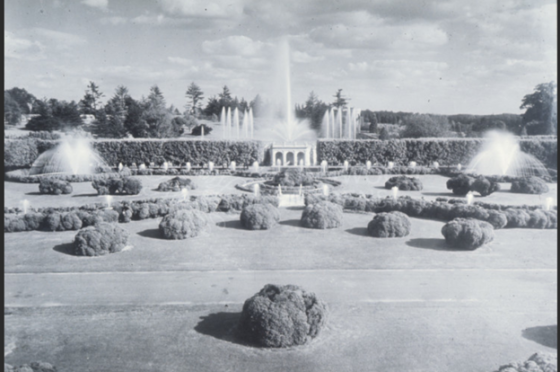
Boxwood in the Main Fountain Garden, 1939. Photo by J.A. Dick.
At Longwood, our first step when dealing with any fungal pathogen is to understand the disease: its lifecycle, how it spreads, and how best to control it. Unfortunately, we have had to address the presence of boxwood blight in our Gardens, initially identified in a portion of tree boxwood in the eastern part of our Gardens. Prompt action was taken, as detailed in a 2021 blog post.
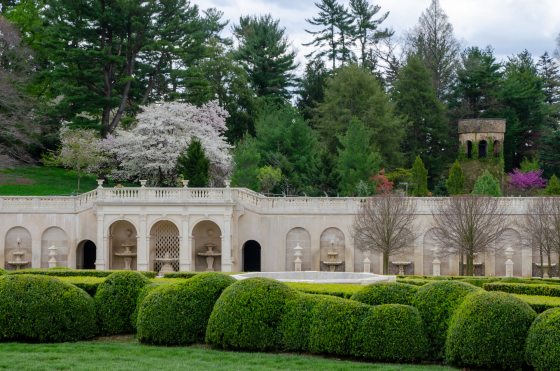
The boxwood in the Main Fountain Garden are Japanese boxwood Buxus microphylla var. japonica ‘Green Beauty’, specifically chosen for their increased resistance to boxwood blight compared to other boxwood varieties. Photo by Amy Simon Berg.
Boxwood blight begins when fungal spores infect the leaves, which then develop dark or light brown spots often bordered by darker edges. Those lesions gradually enlarge and grow together, turning the leaf brown or straw-colored. At this point the symptom begins to appear as a “blight”, with more leaves becoming infected and dead leaves rapidly falling from the plant. However, these symptoms can be easily confused with other boxwood diseases, so we look to the stems for diagnostic symptoms.
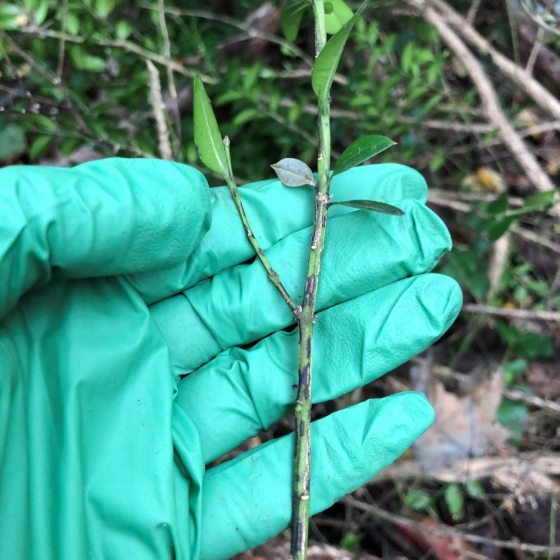
Characteristic boxwood blight stem lesions, with long and thin dark brown to black lesions. Photo by Rachel McDonald.
As the fungus infects stems, characteristic dark brown to black lesions form. These are usually long and thin, similar to the width of a line you would draw with a pencil or pen. Under heavy infection the dying stems and dropping leaves cause overall dieback. The disease does not infect the root system so new growth may occur, but repeated infections will eventually stress the root system beyond recovery, especially in young and newly transplanted boxwoods. Just a single infected leaf can produce thousands of fungal spores, and each spore spread to new leaves has the potential to germinate and penetrate within just five hours. It is also able to survive in the soil for several years where it may be easily spread through water movement, or from plant to plant via water splash. All this is made more complicated because Buxus are not the only host for the disease—Sweet Box (Sarcococca spp.) and Japanese pachysandra (Pachysandra terminalis) can also host boxwood blight.
Here at Longwood, our boxwood blight defenses revolve largely around sanitation. When purchasing new boxwood, we source our plants from nurseries with a boxwood blight cleanliness program that will provide a phytosanitary certificate. The boxwood blight cleanliness program outlines specific sanitation requirements for plant maintenance, tools, crop debris, scouting, inspections, training, and record keeping. We also request that the nursery we’re buying our boxwood from not have had a history of boxwood blight, ensures adequate spacing between plants, and avoids overhead watering. When boxwood shipments arrive onsite, our plant health care team carefully inspects them, monitors them closely for their first 90 days, and then inspects them weekly and monthly during conditions that are ideal for disease development. Conditions most favorable for blight development include the warm, humid weather typically found between the months of July and October with temperatures between 64 degrees F and 77 degrees F.
Our plant health care scouts who inspect for boxwood blight also follow rigorous sanitation. All scouting occurs early in the day before the scouts have worked with other boxwood. Before scouting, scouts sanitize their hands and shoes; while scouting, they wear gloves. If it’s necessary to touch a boxwood plant during the scouting process, gloves are sanitized prior to and after touching the plant.
Our horticulturists have similar sanitation protocols while working around boxwood. Each garden area has separate tools for working with boxwood so that we minimize the risk of disease spread from location to location. Where possible, we avoid driving vehicles near beds with boxwood. We also equip each horticulturist with a bottle of ethanol for easy sanitation of tools, hands, and vehicle tires. We also frequently reference the boxwood blight risk model, produced through the Oregon IPM center and Oregon State University, which predicts the level of blight fungal activity each day and helps predict the best day to do work. If the spore activity is high, we might choose to postpone boxwood work for the day.
By nature, boxwood are susceptible to large amounts of other insects and fungal pathogens, such as Boxwood psyllid, Boxwood leafminer, Boxwood mite, Volutella blight, and Macrophoma leaf spot. Prescence of these pests and fungi could be confused with symptoms of boxwood blight.
Severe infestations of Boxwood leafminer, as one example, brings defoliation and feeding damage that could be confused with the brown lesions of boxwood blight. If you look closely at one of those suspected lesions, you’ll see the brown spots on the leaves look raised, almost puffy. That is where the larvae of the leafminer have overwintered and will emerge in the spring. If you crack open one of those spots, you will usually see active larvae or a space where the larvae previously emerged. The engorged, pouch like spot can help to distinguish leafminer damage from the brown spots from the lesions caused by boxwood blight.
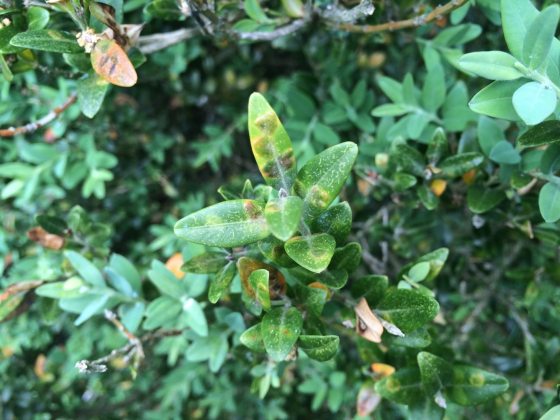
Boxwood leafminer damage, as shown in this photo, can look like a boxwood blight lesion. Photo by Grant Jones.
A fungus that can be confused for boxwood blight, Volutella blight, Volutella buxii, is caused by the Pseudonectria canker. The canker will girdle the boxwood stem and cause leaves to turn yellow, red-bronze, and finally straw-colored, which could be confused with severe boxwood blight infections. During humid, moist conditions, distinct salmon-colored spores will develop when dealing with Volutella blight. The salmon-colored spores are easily distinguished from boxwood blight due to their color, as boxwood blight fungal spores are white. Leaves affected with Volutella blight will also remain on the plant whereas leaves affected with Boxwood blight will fall to the ground.
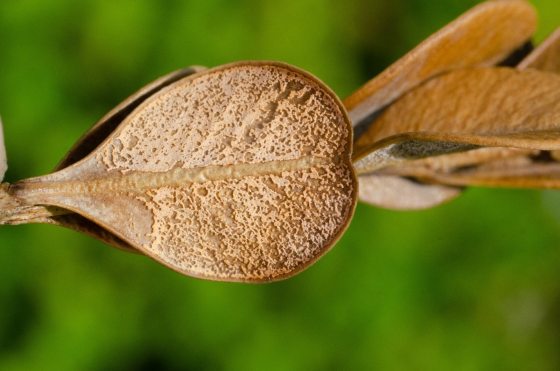
The very distinct salmon-colored spores of Volutella blight. Photo by Dominic Doran.
Volutella blight, Volutella pachysandrae, also affects Japanese pachysandra, another host of boxwood blight. Volutella will cause lesions with concentric rings. Boxwood blight on Pachysandra will begin as a small necrotic lesion with a yellow halo, eventually turning into a larger brown lesion, visible on the upper and lower surfaces of the leaf. Those lesions will not have the concentric circles. While it’s rare to have a boxwood blight infection on Pachysandra that is not close to an infected boxwood, it is still possible and always a good idea to familiarize yourself with the appearance of the various fungal lesions.
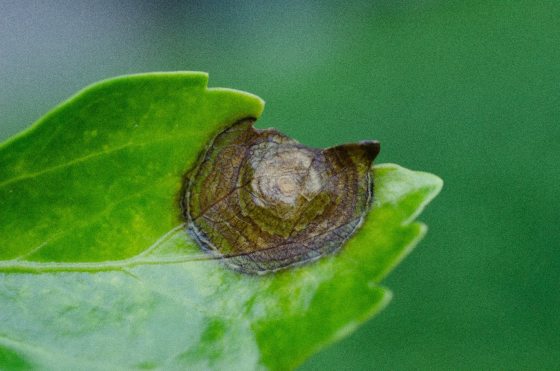
The concentric circles of Volutella on Pachysandra. Photo by Dominic Doran.
If you have boxwoods at home, there are general guidelines you can follow when dealing with sick plants or trying to avoid any plant disease. Disinfect all tools after working with a plant suspected to have a problem. Know the disease symptoms and look for them regularly. Keep any suspect plants in a separate area from healthy plants and do not move around potentially infected plant debris, whether by mulch, on clothing or in vehicles. Wherever possible, use disease-resistant cultivars of a desired plant. Finally, it is always a good idea to promote air flow throughout the plantings and avoid overhead irrigation. If you suspect you have boxwood blight, contacting your local extension service would be a great first step. You can send a picture and potentially a sample for diagnosis. Sadly, boxwood blight is not curable. The only way to ensure the disease does not spread is to remove the infected plant material from the landscape.
Boxwood are an integral part of the history of Longwood Gardens and with the continued dedication of Longwood staff and our plant health care team, and our extensive boxwood blight mitigation strategies, we’re working to help boxwoods maintain their place in the future of our magnificent garden for years to come.
